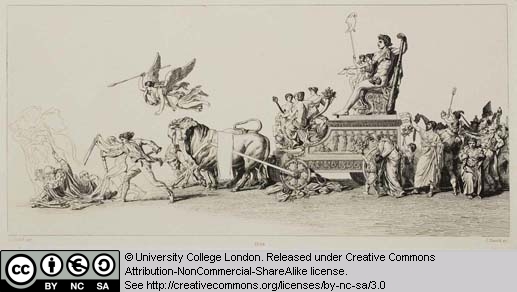13 The Triumph of the French People

Jacques-Louis David
(1748 – 1825)
Le Triomphe du Peuple
Française (The Triumph of the French People) , 1794
Etching
Publisher unrecorded
The design of this complex political allegory by Jacques-Louis
David, without doubt the most celebrated artist of the French Revolution,
was originally intended to decorate the curtain of the Théatre des Arts.
However, his ambitious plan was never realised – if it had not already been abandoned,
the fall of Robespierre in July 1794 would certainly have rendered it impolitic
for a post-terror regime – and like so many other revolutionary projects it
remained on paper only.
The focal point of this crowded print, whose large cast of
characters progress across the picture plane creating a frieze-like effect, is
the figure of the triumphant French people embodied by a crowned figure of
Hercules. He is carried aloft on a richly ornamented chariot similar to those
designed by David for inclusion in the revolutionary processions that he
orchestrated on behalf of the government. Typically, David has drawn directly
on classical sources when composing this image, and both the chariot and its
occupant are direct quotations from an antique source – a Roman sculpted
sardonyx known as the Gemma Augustaea.
Hercules shares the float with the allegorical figures
Licensed under the Creative Commons Attribution Non-commercial Share Alike 3.0 License
This resource has been released as an open educational resource (OER) on a Creative Commons 'Attribution Non-commercial Share Alike' license. This means that once downloaded, content can be modified and improved to complement a particular course. This requires, however, that improvements are recycled back into the OER community. All content present at the time of download must be accordingly credited and, in turn, novel content must be appropriately licensed.